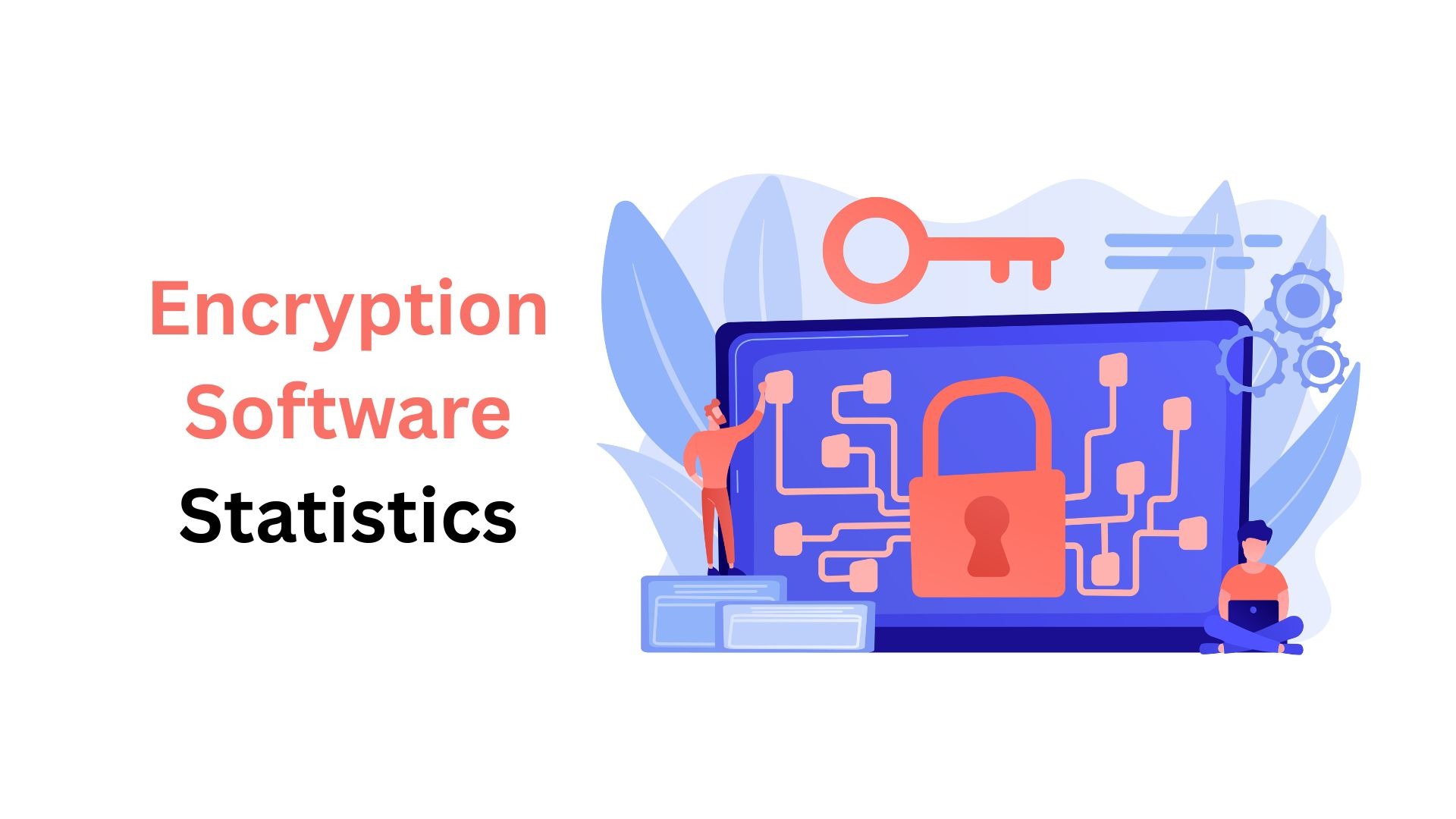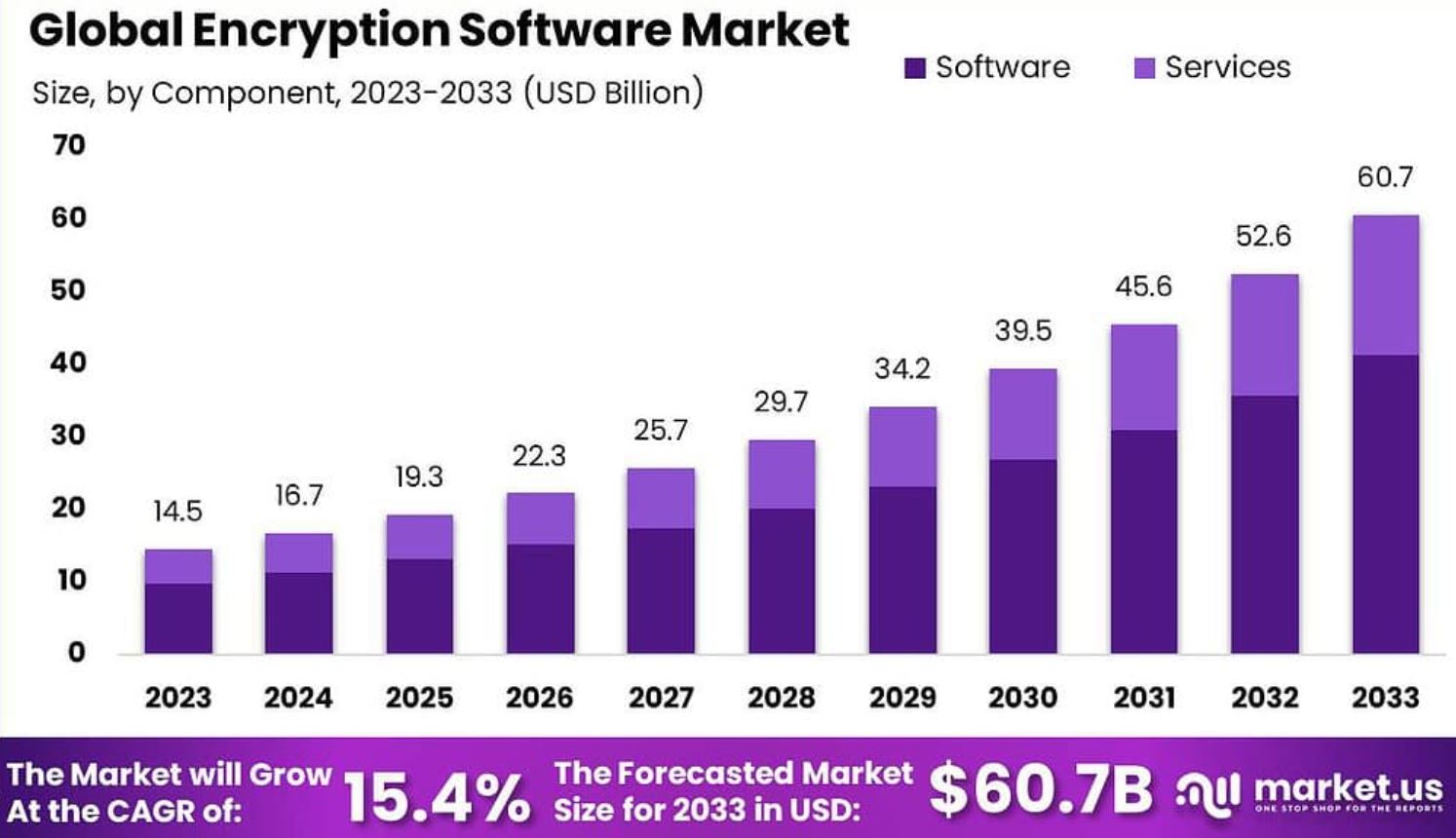Encryption Software Statistics And Facts (2025) : Market Growth, Cloud Breaches & Data Privacy
Updated · Sep 11, 2025

Table of Contents
Introduction
Encryption Software Statistics: Encryption acts as a digital lock that protects sensitive information from unauthorized access. In 2024, the use of encryption software expanded widely across businesses, government organizations, and individuals. The increasing reliance on cloud storage, remote work practices, and stricter privacy regulations has made encryption essential for securing data in transit and at rest. At the same time, the growing number of cyberattacks has further emphasized the need for stronger protection.
For companies, encryption is not only a safeguard for intellectual property and customer information but also a compliance measure to meet international standards. Governments continue to implement encryption for national security, defense, and confidential communications, while civilians use it for securing personal devices, online transactions, and private messaging. As digital ecosystems evolve, encryption has become a foundational layer of cybersecurity, ensuring that data remains confidential and trustworthy across multiple platforms.
With digital transformation reshaping how people and organizations operate, encryption software plays a vital role in building a secure future for both public and private sectors. This article presents the most important encryption software statistics in 2025.
Editor’s Choice
- The global encryption software market, being a massive US$14.5B in 2023, is expected to reach US$60.7B by 2033, at a CAGR of 15.4%.
- Market value projections foreseeing: US$16.7B (2024), US$19.3B (2025), US$22.3B (2026), US$25.7B (2027), and onwards with US$60.7B (2033).
- Cloud is where 50% of encryption data breaches happen, while public cloud breaches cost US$5.02 million against US$4.24 million for the private cloud.
- Valued at US$3.1B in 2023, the cloud encryption market is all set to touch US$45.6B by 2033.
- SMEs will increase their cloud encryption expenditure by 16.8 times from 2023 to 2033.
- North America will witness cloud-encryption adoption growing by 71.5% in 2033 due to intensifying cybersecurity attacks.
- The homomorphic encryption market is valued at US$150 million in 2021 and is anticipated to cross US$300 million by 2030 at a CAGR of 9%.
- By 2022, 47% of companies are reported to store 60% or more of sensitive data on encrypted cloud platforms; nevertheless, 64% reported that they were hindered by data-discovery issues.
- AES has been set as the global standard upon which 128-, 192-, and 256-bit keys are supported and is retained by RSA (2048-bit/4096-bit) and Twofish (up to 256 bits).
- 95% of organisations responded that they consider data privacy investments crucial to success.
- 36% reported that at least double the return on investment was achieved with these investments.
Encryption Software Market

(Source: scoop.market.us)
- As per the scoop market, encryption software statistics show that the encryption software market is on a rapid ascent.
- In 2023, revenues stand at nearly US$14.5 billion, expected to reach US$60.7 billion in 2033, letting the market a CAGR of 15.4%.
- Energy-wise, the market is forecasted at US$16.7 billion in 2024 and shall steadily climb every subsequent year: US$19.3 billion in 2025, US$22.3 billion in 2026, and US$25.7 billion in 2027, among others.
- However, this steady growth is far from stopping here; by 2028, it is predicted to hit the height of US$29.7 billion, then at US$34.2 billion in 2029 and US$39.5 billion in 2030.
- Consequently, the market is expected to enter a much faster growth phase, with values reaching US$45.6 billion in 2031, US$52.6 billion in 2032, and a grand peak of US$60.7 billion by 2033.
- This steady rise further corroborates the fact that much demand has been created of late for encryption as businesses and governments seek stronger tools for protection against ever-smartening LG and cybercriminals.
Growth of Enterprise Encryption Adoption Across Industries
- As industries around the world made massive strides in adopting enterprise-wide encryption from 2012 to 2022, it has become evident that data protection is paramount in any sector.
- Leading the charge was the technology and software industry, which saw its encryption adoption spike from 31% to 72%, while indicating a level of leadership in cybersecurity practices.
- The manufacturing sector nearly rivalled the technology sector, climbing from 17% to 71%, signifying a serious shift in focus toward data security within production environments.
- The public sector also recorded a notable increment from 23% to 69%, demonstrating the renewed vigour amongst governments to protect sensitive documents and citizen information.
- Financial services, while already high at 38% in 2012, went up to 65%, underlining a continuing will of the sector in protecting confidential financial information.
- Consequently, the market is expected to enter a much faster growth phase, with values reaching US$45.6 billion in 2031, US$52.6 billion in 2032, and a grand peak of US$60.7 billion by 2033.
- This steady rise further corroborates the fact that much demand has been created of late for encryption as businesses and governments seek stronger tools for protection against ever-smartening threats and cybercriminals.
- This difference conveys that breaches into the public cloud may tend to cost more.
- The cloud encryption market itself is blossoming with huge potential.
- It was valued at US$3.1 billion in 2023, comprising about 4.5% of the total cloud security market, and is predicted to skyrocket to US$45.6 billion by 2033.
- North America tops this growth, as adoption is expected to rise at a staggering 71.5% by 2033, with the growing tide of cyberattacks.
- Meanwhile, SMEs are also poised to increase their spending on cloud encryption by a staggering 16.8-fold between 2023 and 2033.
- Homomorphic encryption is another interrelated space that processes data without decrypting it; it was US$150 million in 2021 and is projected to surpass US$300 million by 2030, growing at 9% CAGR.
- The other interesting thing is market concentration, with the biggest 5 vendors holding about 33% of the cloud encryption market in 2023.
- Some prominent players are IBM, Trend Micro, Sophos, WinMagic, Atos, and Hewlett-Packard Enterprise.
- Back in 2021, 83% of companies were still not encrypting their cloud data, leaving themselves defenceless against expensive attacks.
- At that time, 24% of U.S. organisations were keeping all their data in the cloud, amplifying the risk.
- Among those who chose to encrypt, 35% used their own encryption tools, and the remaining 55% went with the method their cloud service providers offered.
- This changed for the better in 2022, as 47% of companies claimed to store more than 60% of their most sensitive data in encrypted cloud platforms.
- Data discovery challenges notwithstanding, 64% felt that their pace of adoption for encryption was slowed by these challenges, another example of possible technical barriers.
- The numbers altogether make the point that, under ever-increasing cyber threats, regulatory pressures, and the demand to keep its data safe, cloud encryption becomes an option no longer.
Encryption Standards Fields
- Encryption standards evolve in time along with any increased demand for security.
- Once, DES was considered worthy of choosing now it is deemed insecure because a key length of 56 bits can be broken by modern computers.
- When it comes to improving upon DES, Triple DES works by encrypting data three times with three separate 56-bit keys.
- That little magic there made it stronger than DES itself, though it still does not quite meet present-day standards.
- AES, due to its speed and versatility, has emerged as the global standard, supporting key lengths of 128, 192, and 256 bits, giving that nice balance between security and practical application.
- RSA does have a brilliant reputation as well for security, but because of huge keys (commonly 2048 and 4096 bits), it makes it a little slower than symmetric ones like AES.
- Another suitable alternative that also basks in the fame of Twofish is, in fact, very fast and supports a key size of up to 256 bits, which provides a strong layer.
Security And Compliance
- Managing encryption means not only implementing strong algorithms but also following strict guidelines for key handling and compliance.
- Symmetric and asymmetric key management includes generating, rotating, and destroying keys such as AES-256, RSA (2048, 3072, 4096), and elliptic curve keys such as EC P256 and EC P384.
- Organisations rely on HSMs that have achieved FIPS 140-2 Level 3 validation to ensure that these keys remain secure; storing keys securely with the highest level of security also means performing cryptographic operations.
- Key rotation should happen at least once every 24 hours or after encrypting 64 GB of data for best practice, and doing so would prevent attacks from occurring due to prolonged use of the same key.
- Enforcement of secure key storage and standards compliance, for instance, with FIPS 140-2 comes directly from an HSM.
- Looking into data protection from a business perspective, most organisations realise that it is something beyond pure security that pertains to success.
- In fact, 95% of organisations assert that investments in data privacy are vital for their business goals, while approximately 36% assert that they gain at least twice the amount of their investments in such protections.
- Legal and regulatory compliance also motivates this. Laws, such as the GDPR in Europe, and industry standards such as SOC 2, HIPAA, and PCI DSS, require companies to follow strong encryption and secure framework practices.
- These practices ensure compliance and trust and reduce the risk of data breach.
Conclusion
Encryption Software Statistics: In conclusion, things like encryption software serve as the pillar of cybersecurity businesses in 2024, being the engine of compliance and business growth. With predicted market escalation from US$16.7 billion in 2024 to US$60.7 billion by 2033, there looks to be no slowing down of adoption among industries and cloud platforms. Cloud breaches are making a forceful argument for stronger defences, while standards like AES and RSA remain default tools.
Companies foresee encryption as an enabler for their business. About 95% consider privacy investment as correlated to success. With increased threats from cyber attackers, encryption is not an option anymore – it is trust, security, and resilience for this digital age.
FAQ.
Relative to market size, it is US$16.7 billion in 2024, which was US$14.5 billion in 2023. And it is very fast in growth, expected to be US$60.7 billion in 2033, with a 15.4% CAGR.
Across all industries, the trend is one of encryption adoption between 2012 and 2022. The technology and software sectors are first, having risen from 31% to 72%. Manufacturing closely follows in second position, with an adoption increase from 17% to 71%. Public sector adoption increased from 23% to 69%, and financial services grew from 38% to 65%.
Because almost 50% of encrypted data breaches currently take place in the cloud, cloud encryption has become essential. The average cost deposition for public cloud setup breaches stands at US$5.02 million, whereas for private cloud instances, it is US$4.24 million. At present, the cloud encryption market is witnessing considerable growth as it is valued at US$3.1 billion in 2023 and expected to touch US$45.6 billion by 2033.
Modern encryption relies on secure algorithms that are meant to resist advanced cyber-threats. AES is the most widely used method, coming in 128-, 192-, and 256-bit key sizes to allow the user more choice and facilitate greater efficiency. RSA encryption is still widely used and employs 2048- or 4096-bit keys, but is slower compared to AES. Another strong choice is Twofish, accepting keys up to 256 bits, yet somewhat less widely accepted.
The purpose of encryption is to ensure compliance with increasingly stringent regulations on data protection, such as GDPR, SOC 2, HIPAA, and PCI DSS. Organisations employ Hardware Security Modules (HSMs) compliant with FIPS 140-2 Level 3 standards to securely manage keys such as AES-256 keys, RSA keys, and elliptic curve keys. 95% of organisations consider their investments in data privacy key to their success, and 36% have indicated an ROI of at least twofold on these investments.

I hold an MBA in Finance and Marketing, bringing a unique blend of business acumen and creative communication skills. With experience as a content in crafting statistical and research-backed content across multiple domains, including education, technology, product reviews, and company website analytics, I specialize in producing engaging, informative, and SEO-optimized content tailored to diverse audiences. My work bridges technical accuracy with compelling storytelling, helping brands educate, inform, and connect with their target markets.










